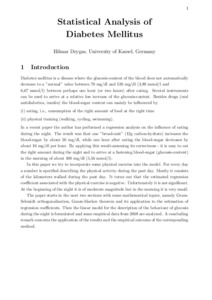Statistical Analysis of Diabetes Mellitus
| dc.date.accessioned | 2009-05-06T10:49:59Z | |
| dc.date.available | 2009-05-06T10:49:59Z | |
| dc.date.issued | 2009 | |
| dc.identifier.uri | urn:nbn:de:hebis:34-2009050627175 | |
| dc.identifier.uri | http://hdl.handle.net/123456789/2009050627175 | |
| dc.format.extent | 126481 bytes | |
| dc.format.mimetype | application/pdf | |
| dc.language.iso | eng | |
| dc.rights | Urheberrechtlich geschützt | |
| dc.rights.uri | https://rightsstatements.org/page/InC/1.0/ | |
| dc.subject | Statistical Analysis | eng |
| dc.subject | Diabetes Mellitus | eng |
| dc.subject.ddc | 510 | |
| dc.title | Statistical Analysis of Diabetes Mellitus | eng |
| dc.type | Preprint | |
| dcterms.abstract | Diabetes mellitus is a disease where the glucosis-content of the blood does not automatically decrease to a ”normal” value between 70 mg/dl and 120 mg/dl (3,89 mmol/l and 6,67 mmol/l) between perhaps one hour (or two hours) after eating. Several instruments can be used to arrive at a relative low increase of the glucosis-content. Besides drugs (oral antidiabetica, insulin) the blood-sugar content can mainly be influenced by (i) eating, i.e., consumption of the right amount of food at the right time (ii) physical training (walking, cycling, swimming). In a recent paper the author has performed a regression analysis on the influence of eating during the night. The result was that one ”bread-unit” (12g carbon-hydrats) increases the blood-sugar by about 50 mg/dl, while one hour after eating the blood-sugar decreases by about 10 mg/dl per hour. By applying this result-assuming its correctness - it is easy to eat the right amount during the night and to arrive at a fastening blood-sugar (glucosis-content) in the morning of about 100 mg/dl (5,56 mmol/l). In this paper we try to incorporate some physical exercise into the model. | eng |
| dcterms.accessRights | open access | |
| dcterms.creator | Drygas, Hilmar | |
| dcterms.isPartOf | Mathematische Schriften Kassel ;; 09, 01 | ger |
| dcterms.source.journal | Mathematische Schriften Kassel | ger |
| dcterms.source.volume | 09, 01 |

